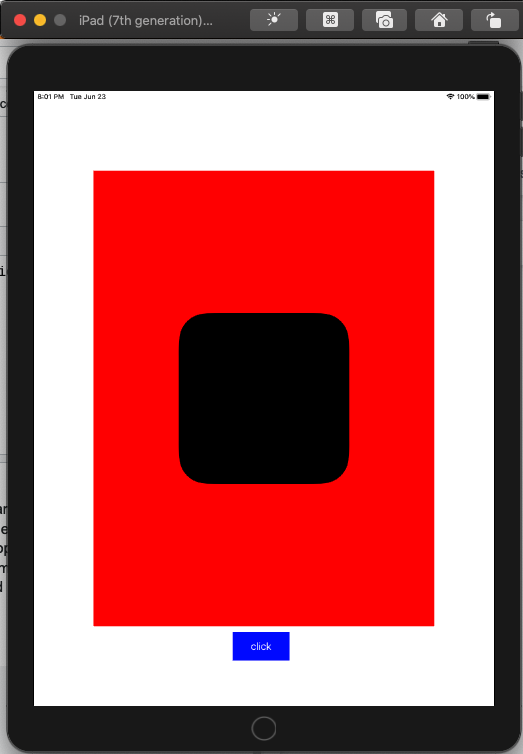

我创建了UIView,它有一个子视图,它包含使用UIBEZIERPath创建的shape对象,并且UIView具有固定的高度和宽度(图1)。 当我点击蓝色按钮时,它应该缩小到另一个固定的宽度和高度。 我已经将CGaffineTransform应用到子视图中,我猜它是正确地缩小的,但是由于TopAnchor和LeftAchor具有常量值,缩小后它不能正确显示(图2)。我将在这里附上我的源代码和屏幕截图,请分析一下,有人能建议更好的方法吗? 并非常感谢您的反馈和意见。
代码:
import UIKit
class ViewController: UIViewController {
var screenView: UIView!
var button: UIButton!
let widthOfScaleDownView: CGFloat = 200
let heightOfScaleDownView: CGFloat = 300
override func viewDidLoad() {
screenView = UIView(frame: .zero)
screenView.translatesAutoresizingMaskIntoConstraints = false
screenView.backgroundColor = UIColor.red
self.view.addSubview(screenView)
NSLayoutConstraint.activate([
screenView.heightAnchor.constraint(equalToConstant: 800),
screenView.widthAnchor.constraint(equalToConstant: 600),
screenView.centerYAnchor.constraint(equalTo: self.view.centerYAnchor, constant: 0),
screenView.centerXAnchor.constraint(equalTo: self.view.centerXAnchor, constant: 0)
])
button = UIButton()
button.translatesAutoresizingMaskIntoConstraints = false
button.backgroundColor = UIColor.blue
self.view.addSubview(button)
NSLayoutConstraint.activate([
button.heightAnchor.constraint(equalToConstant: 50),
button.widthAnchor.constraint(equalToConstant: 100),
button.topAnchor.constraint(equalTo: self.view.topAnchor, constant: 950),
button.leftAnchor.constraint(equalTo: self.view.leftAnchor, constant: 350)
])
button.setTitle("click", for: .normal)
button.setTitleColor(UIColor.white, for: .normal)
button.addTarget(self, action: #selector(scaleDownView(_:)), for: .touchUpInside)
let shapeView = UIView(frame: .zero)
shapeView.translatesAutoresizingMaskIntoConstraints = false
let rect = CGRect(x: 0, y: 0, width: 300, height: 300)
let shape = UIBezierPath(roundedRect: rect, cornerRadius: 50)
let layer = CAShapeLayer()
layer.path = shape.cgPath
layer.lineWidth = 2
shapeView.layer.addSublayer(layer)
screenView.addSubview(shapeView)
NSLayoutConstraint.activate([
shapeView.topAnchor.constraint(equalTo: screenView.topAnchor, constant: 250),
shapeView.leftAnchor.constraint(equalTo: screenView.leftAnchor, constant: 150)
])
}
@IBAction func scaleDownView(_ sender: UIButton) {
let widthScale = widthOfScaleDownView/screenView.frame.width
let heightScale = heightOfScaleDownView/screenView.frame.height
screenView.subviews.forEach{ view in
view.transform = CGAffineTransform(scaleX: widthScale, y: heightScale)
}
NSLayoutConstraint.activate([
screenView.heightAnchor.constraint(equalToConstant: heightOfScaleDownView),
screenView.widthAnchor.constraint(equalToConstant: widthOfScaleDownView),
screenView.centerYAnchor.constraint(equalTo: self.view.centerYAnchor, constant: 0),
screenView.centerXAnchor.constraint(equalTo: self.view.centerXAnchor, constant: 0)
])
}
}


几件事。。。
1-当您使用CGaffineTransform更改视图时,它将自动影响视图的子视图。 所以不需要循环。
2-转换是累积的,因此当“返回”到原始刻度时,使用.identity而不是另一个刻度转换。
3-不能多次设置约束。 所以如果你做了:
screenView.heightAnchor.constraint(equalToConstant: 800)
然后你也会:
screenView.heightAnchor.constraint(equalToConstant: heightOfScaleDownView)
您将获得自动布局冲突。。。 视图不能同时具有800分高和300分高。
请看一下我对您的代码所做的更改。 我还在缩放变换中添加了一个1秒的动画,这样你就可以看到它在做什么:
class ViewController: UIViewController {
var screenView: UIView!
var button: UIButton!
let widthOfScaleDownView: CGFloat = 200
let heightOfScaleDownView: CGFloat = 300
override func viewDidLoad() {
screenView = UIView(frame: .zero)
screenView.translatesAutoresizingMaskIntoConstraints = false
screenView.backgroundColor = UIColor.red
self.view.addSubview(screenView)
// constrain screenView
// width: 800 height: 600
// centered X and Y
NSLayoutConstraint.activate([
screenView.heightAnchor.constraint(equalToConstant: 800),
screenView.widthAnchor.constraint(equalToConstant: 600),
screenView.centerYAnchor.constraint(equalTo: self.view.centerYAnchor, constant: 0),
screenView.centerXAnchor.constraint(equalTo: self.view.centerXAnchor, constant: 0)
])
button = UIButton()
button.translatesAutoresizingMaskIntoConstraints = false
button.backgroundColor = UIColor.blue
self.view.addSubview(button)
NSLayoutConstraint.activate([
button.heightAnchor.constraint(equalToConstant: 50),
button.widthAnchor.constraint(equalToConstant: 100),
button.topAnchor.constraint(equalTo: self.view.topAnchor, constant: 950),
button.leftAnchor.constraint(equalTo: self.view.leftAnchor, constant: 350)
])
button.setTitle("click", for: .normal)
button.setTitleColor(UIColor.white, for: .normal)
button.addTarget(self, action: #selector(scaleDownView(_:)), for: .touchUpInside)
let shapeView = UIView(frame: .zero)
shapeView.translatesAutoresizingMaskIntoConstraints = false
let rect = CGRect(x: 0, y: 0, width: 300, height: 300)
let shape = UIBezierPath(roundedRect: rect, cornerRadius: 50)
let layer = CAShapeLayer()
layer.path = shape.cgPath
layer.lineWidth = 2
shapeView.layer.addSublayer(layer)
screenView.addSubview(shapeView)
// constrain shapeView
// width: 300 height: 300
// centered X and Y in screenView
NSLayoutConstraint.activate([
shapeView.widthAnchor.constraint(equalToConstant: 300.0),
shapeView.heightAnchor.constraint(equalToConstant: 300.0),
shapeView.centerXAnchor.constraint(equalTo: screenView.centerXAnchor),
shapeView.centerYAnchor.constraint(equalTo: screenView.centerYAnchor),
])
}
@IBAction func scaleDownView(_ sender: UIButton) {
let widthScale = widthOfScaleDownView/screenView.frame.width
let heightScale = heightOfScaleDownView/screenView.frame.height
UIView.animate(withDuration: 1.0) {
// if we have already been scaled down
if widthScale == 1 {
// animate the scale transform back to original (don't add another transform)
self.screenView.transform = .identity
} else {
// animate the scale-down transform
self.screenView.transform = CGAffineTransform(scaleX: widthScale, y: heightScale)
}
}
// do NOT change screenView constraints!
}
}